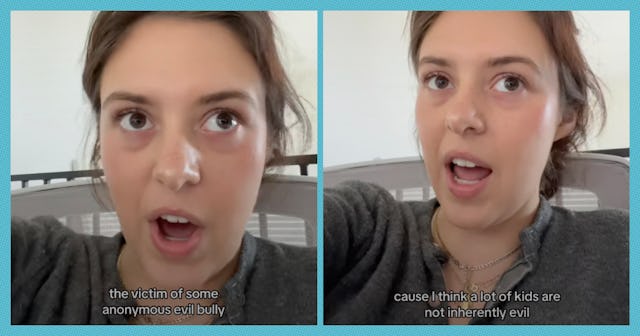Anti-Bullying Education Might Be Missing One Key Element When Teaching Kids
It’s the twist we never saw coming... but probably should have.

The most Millennial thing about me is my deep love of 30 Rock, and one of my favorite episodes is when Liz Lemon goes to her high school reunion — a successful, sophisticated New York TV writer — to stick it to all her bullies. But once she arrives, she reaches a horrible realization: she wasn’t bullied. She was the bully, even though she never saw it that way herself. Indeed, it’s a rare thing to be able to really see ourselves as the bad guy... and, as TikTok user Rachel (@rachel.the.editor) points out, it starts young.
“Have we ever considered the fact that anti-bullying messaging for kids is often centered around the victim and some anonymous evil bully and never teaching kids to recognize when they are being the bully?” she asks.
“Because I think a lot of kids are not inherently evil, they just don’t realize [or] have the emotional maturity to know the effect that they’re having on other kids. I think that we should probably be telling kids how to recognize when you’re being a bully. That’s almost more important than learning how to deal with this anonymous, shapeless, evil bully figure.”
Commenters chimed in with their experiences regarding shortcomings in bullying education
“The amount of times I've talked to kids being ‘bullied’ only for it to turn out they are the ones antagonizing the other students,” one commenter lamented. “No one wants to play with you because when you lose you hit them!”
“YES cuz usually the ‘bully' =; in these existing stories is so cartoonishly evil that real life bullies probably go ‘Obviously that’s not me, I’m just messing around and having fun,’” observes another. “They’ve no clue.”
Others pointed out that identifying friends as bullies can be difficult for kids, as well as determining the difference between bullying (sustained behavior) and isolated incidents of mean-ness.
And, of course, parents probably have a hard time recognizing or acknowledging that their child is a bully.
StopBullying.gov points out that bullying is a behavior that can be changed and often comes from a place of insecurity or a desire for control that they otherwise don’t feel they have in their lives or relationships. Children who bully may need help learning how to cope with their emotions.
The American Academy of Pediatrics (AAP) offers advice to caregivers to help their children avoid or stop bullying.
“You cannot always help your child avoid all bullying,” they note. “But you can help him build coping skills to deal with difficult situations. Spend time with your child, show him love and encouragement, and model good behavior toward others. Talk through difficult situations with your child so he knows he can trust you with his problems.”
AAP goes on to note that bullying behavior often gets worse if not addressed, even into adulthood. Fortunately, helping your kid is something in your control, and not just in helping them understand why it’s wrong, redirecting their aggression, or monitoring their online activities.
“Be a positive role model,” they advise. “Children need to develop new and constructive ways of getting what they want. All children can learn to treat others with respect.”